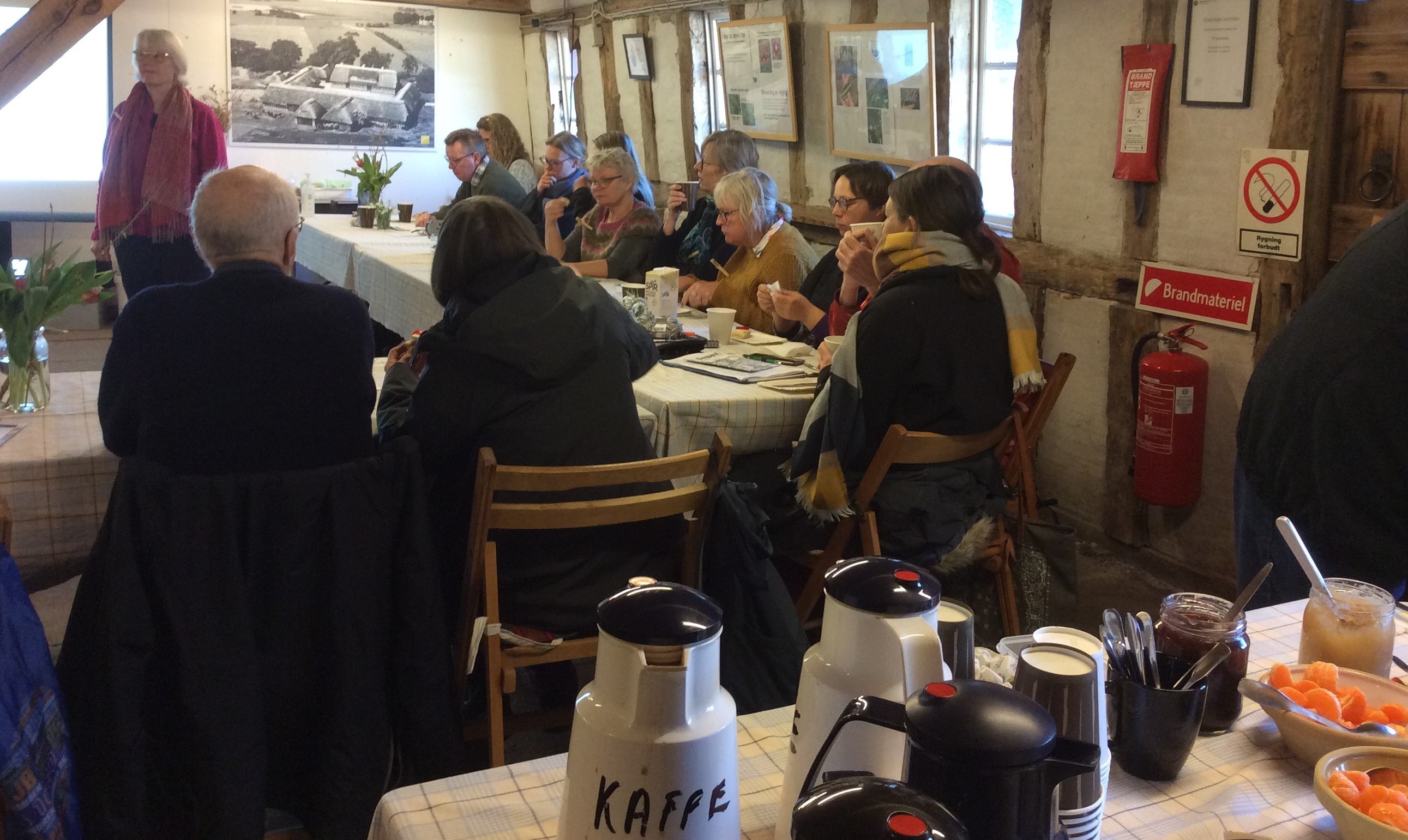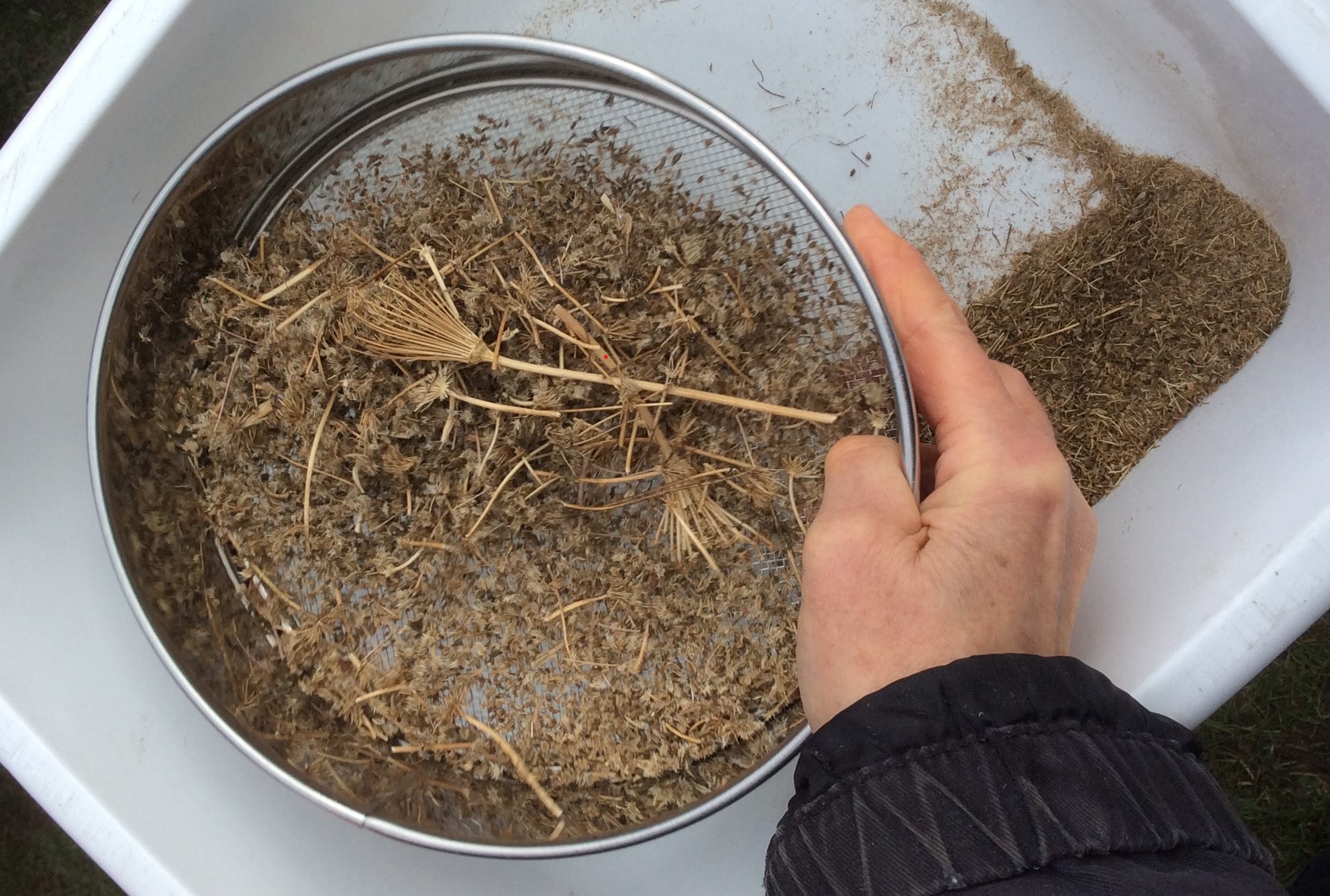Vivi Logan teaching practical seed saving outside at Kringsminde Museum
All photos: Charlotte Snebæk Poulsen
Course in seed saving for people connected to Kringsminde Museum
By Vivi Logan, member of the Danish Seed Savers
- Date: 5.3. 2022
- Place: Kringsminde Museum, Kringsmindevej 9, 7000 Fredericia
- Time: 10.00 am – 14.00 pm
- Course teacher: Seed Saver Vivi Logan
- Course assistant: Project manager Charlotte Snebæk Poulsen
- Participants: 24 persons participated in the course (11 Co-workers and volunteers from the museum, 13 Members of the Danish Seed Savers)

Course contents:
1) Presentation of the Project “Growing Seed Savers in Museums” and background for the project
Charlotte Snebæk Poulsen told the participants about the inspiration for “Margrethe’s Kitchen Garden” in Kringsminde. Margrethe Hvid was the first Danish, female garden consultant, and the garden was created according to Margrethe Hvid’s book “Køkkenurter: Dyrkning og Konservering” (Kitchengarden Vegetables: Growing and Preserving) from 1943. Charlotte emphasized the difficulties in finding seeds of the exact vegetable variety that was used in 1943. The museum garden was made with the help of volunteers.
2) Seed saving theory
- Why saving pure-bred seeds and especially in museums?
- Basic knowledge in the difference between plant family, species, subspecies, varieties, and the scientific names of plants.
- Basic plant biology for seed savers.
- Pollination: Self-pollinators, cross-pollination, insects, wind or hand-pollination
- Open-pollinated seeds versus F1 hybrids
- Seed propagation, clones – vegetative propagation
- Easy or more difficult plants to start with.
- Isolation, distance, barriers between varieties and numbers of plants to grow to keep the gene content high and reduce risk of inbreeding depression.

3) The practical part, shown mainly outside
- Harvest, cleaning and threshing dry seeds gave participants the possibility to see and touch seeds, i.e. carrot seeds, that in their natural form don’t look much like the carrot seeds one buys.
- Wet seeds i.e. tomatoes, cleaning, fermenting, and drying of wet seeds.
- Labels, record keeping, storing of seeds. “Good practice”.

After all the Corona lockdown it was a delight to have a room full of people interested in old varieties of seeds, plants and interested in helping to learn about seed saving to keep the old varieties alive. There was also great interest in the ways the museum showcase life, tools etc. from long ago. The participants had a possibility to have a look inside in the old-fashioned kitchen with a wood burning stove, that makes it possible to recreate the taste of food from when some of the seed varieties were originally created.
The group consisted of both people with good knowledge of seed-saving, little knowledge, and beginners. We were lucky that one of the participants is a professional seed-breeder, so he helped with his knowledge in breeding large portions, threshing and keeping seeds pure on a field-scale.
The participants were very interested in the subject and asked a lot of questions and even seed savers with a good deal of experience learned something new i.e. “I never thought I that the varieties my neighbors grow in their gardens, can influence the seed saving in my garden.
Both at the lunch break and for an hour after the course had ended, we had the possibility of swapping seeds, stories, knowledge, and general chatting about plants, seeds, and museums. Charlotte had brought the Seed Savers Market seed-box, giving people the possibility to buy some of the old varieties, which was very popular.
The museum cooked lunch for us using old recipes, but due to the time of the year mainly with store-bought ingredients.
An added benefit by including non-museum people was that more were interested in becoming volunteers in the museum and to help running “Margrethes Køkkenhave” this year.